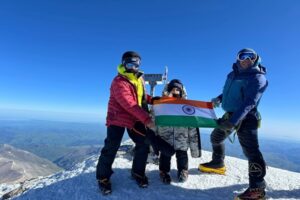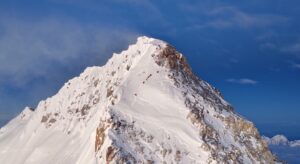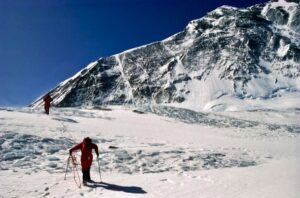Climbers are not there yet, but Everest‘s South Side Base Camp — the most profitable business in Nepal –is already bustling with activity. At the same time, there is a real effort to make the place safer and cleaner.
The best tent locations on the Khumbu Glacier were reserved about a month ago when commercial outfitters sent staff to mark the best slots with flags. Since then, porters and helicopters have been shuttling loads and building tent platforms and mess areas for their guests, who begin to arrive in April.

Icefall Doctors will soon fix the Khumbu Icefall. Photo from last year: SPCC
Icefall Docs on their way
The real start of the climbing season will occur when the Sherpa team assigned by Sagarmatha Pollution Control Committee arrives in Base Camp. They left Namche Bazaar on Monday.
The team includes eight of the so-called Icefall Doctors (Ang Sarki Sherpa, Chhewang Nuru Sherpa, Dawa Jangbu Sherpa, Dawa Nuru Sherpa, Mingma Temba Sherpa, Pemba Tshering Sherpa, Sonam Tshering Sherpa, and Tenzing Dorjee Sherpa). They will fix and maintain the route across the fearsome Khumbu Icefall.
With them were two kitchen staff (Nawang Thaten Sherpa and Wangdi Gelbu Sherpa), a Base Camp manager (Tshering Tenzing Sherpa), and Sanjiv Tamang, who is in charge of garbage management.

The 2023 Icefall Doctors and support workers before leaving for Everest BC. Photo: SPCC
In addition to their work on the Khumbu icefall, the SPCC has a major role in garbage management, not only in Base Camp but above it. Workers will follow the “8kg rule” that SPCC implemented in 2015. Every climber above Everest Base Camp must bring back at least 8 kg of garbage. (Porters will carry the clients’ eight kilos.)
Last spring, the various expedition teams brought down 3,767kg of garbage from above Base Camp, said the SPCC.

Garbage management: SPCC staff removing garbage from the base of the Khumbu Icefall. Photo: Sagarmatha Pollution Control Committee
Clean-up initiatives
The SPCC is a nonprofit Sherpa organization in the Khumbu valley. They perform year-round environmental work and frequently enlist the help of foreign visitors. Last fall, some Everest Base Camp trekkers participated in the “carry me back” initiative. They packed semi-processed recyclable materials, such as aluminum cans and PET bottles, back from the upper Khumbu lodges to a recycling point near Namche Bazaar.

Bringing back old ropes and aluminum ladder sections from the Khumbu Icefall. Photo: SPCC
Yet the SPCC’s best-known task is the risky work done every spring by the Icefall Doctors amid the maze of seracs and crevasses blocking the way up Everest, Lhotse, and Nuptse. The Sherpa team attends on-site training from instructors of the Khumbu Climbing Center at Everest Base Camp until March 6.
Then they start searching for the safest route through the Icefall and fix it up to the Valley of Silence, where Camp 2 is located. The SPCC charges $600 per climber for the right to use the route through the Icefall. The outfitters pay on their clients’ behalf.
The rope-fixing business
From Camp 2 to the summit, the rope-fixing work is in the hands of one of the local outfitters from Nepal’s Expedition Operators Association. Since 2016, the EOA assigns the task of fixing the ropes on Everest and the rest of Nepal’s 8,000’ers, plus Ama Dablam, to the lowest bidder.
Seven Summit Treks, the biggest operator in Nepal, has fixed the route up Everest in recent years. It provides both the personnel and the equipment (including over 1,600m of rope, according to The Kathmandu Post) and charges climbers in Base Camp who use the ropes.

Seven Summit Treks staff pose last spring by the company’s headquarters in Kathmandu, with the spools of rope ready to fix on Everest. Photo: Seven Summit Treks
The Icefall Doctors have changed the game for all Everest climbers, but theirs is high-risk work. In recent years, helicopters carry ropes, gear, and sometimes the Sherpas themselves above the Icefall, so they can fix the route from Camp 2 without passing through this hazardous area. Yet there is no way to improve safety for those fixing the Icefall itself.
Risks and alternatives
The Himalayan Database reports that 44 people have died in the Icefall until 2021. In 2014, a serac fell from the West Shoulder right on the Icefall and killed 16 Sherpas. Last year, a Sherpa working with IMG also died there. In this case, however, it was a medical problem rather than an accident.
Above, a video of helicopters flying from Camp 2 to Everest Base Camp.
Batard again
Marc Batard of France is returning again to find and fix an alternative route to Camp 2 that avoids the Icefall by traversing the flank of Nuptse. He has been working on it for the past two years. In April, he and a small team will try again.
The goal is, he says, to avoid any further catastrophes in the Icefall, such as the one that occurred in 2014. However, there is some skepticism about his project. Some outfitters fear that the alternative route might be too difficult or even as risky as the Icefall, especially for heavily loaded workers.






